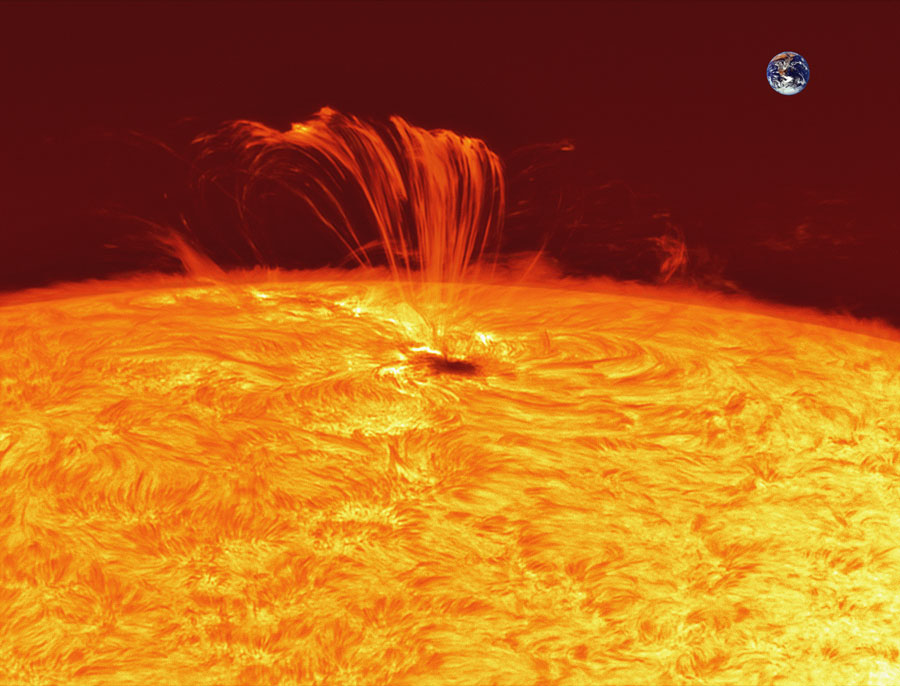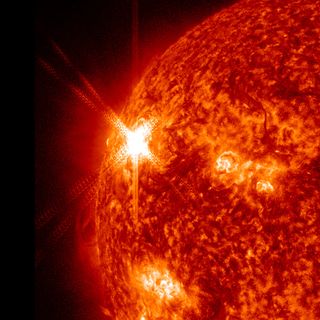
A relatively quiet stretch for the sun in recent years does not necessarily herald an impending solar activity low of historic proportions, a new study reports.
The sun was quiescent from 2005 to 2010, spouting off relatively few flares and eruptions of solar plasma known as coronal mass ejections (CMEs). That dry spell lasted about twice as long as usual, prompting some scientists to predict that a "grand minimum" of solar activity — the likes of which hasn't been seen in 300 years — could be on the way.
But the opposite could just as easily be true, the study suggests.
"[A]fter looking at data of past solar activity, we have pointed out that it is just as likely that the sun will go into a grand maximum again (it just came out of one) than into a grand minimum," said study lead author Sami Solanki, of the Max Planck Institute for Solar System Research (MPISSR) in Katlenburg-Lindau, Germany.
"However, neither of these is likely to happen within the next 30 years or so," Solanki told SPACE.com via email. "Most probable is that the sun will continue at a moderate level of activity (such as displayed in the present solar activity cycle)." [Stunning Photos of Solar Flares & Sun Storms]
A new "Maunder minimum?"
Solar activity waxes and wanes on an 11-year cycle, but it also displays broader patterns over longer time scales. The sun's rumblings are of interest to us on Earth, as solar flares and CMEs can knock out satellites and temporarily disrupt communications systems and power grids.
Get the Space.com Newsletter
Breaking space news, the latest updates on rocket launches, skywatching events and more!
Scientists have been tracking solar activity for about 300 years by noting the comings and goings of sunspots, temporary dark patches on the solar surface that often give rise to powerful flares and CMEs.
These records show that virtually no sunspots were observed from 1645 to 1715 — a period of prolonged solar quiescence now known as the Maunder minimum.
The sun recently came out of a 70-year-long "grand maximum" of high activity, and some astronomers have suggested that our star could now be transitioning toward another Maunder-like minimum.

Studying the sun's past
Solanki and co-author Natalie Krivova, also of MPISSR, investigated this possibility by studying the sun's past. They combed through the old sunspot data but also looked at records of certain isotopes of the elements carbon and beryllium, which allowed them to go back much further in time.
These isotopes, carbon-14 and beryllium-10, are produced when fast-moving cosmic ray particles slam into Earth's atmosphere. Because solar storms help sweep cosmic rays away from our planet, the abundance of carbon-14 and beryllium-10 enables researchers to reconstruct the sun's activity as far back as 11,000 years ago.
Solanki and Krivova used all this information to get a broad sense of how the sun behaves over long time periods. There's an 8 percent probability that a grand minimum will follow a just-ended grand maximum within 40 years, they found, and those odds rise to 40 or 50 percent within 200 years.
But it's just as likely that another grand maximum will occur before a grand minimum finally arrives; that's what happened after half of the grand maxima over the past 11,000 years.
"It is not even clear in which direction solar activity will develop in the longer term," Solanki and Krivova write in the study. "Thus, the next grand extremum is just as likely to be a maximum as a minimum."
Solanki and Krivova report their results in the Nov. 18 issue of the journal Science.
Forecasting space weather
Scientists are getting better and better at predicting solar activity hours or days in advance, thanks in large part to sun-watching spacecraft such as NASA's Solar Dynamics Observatory (SDO) and the Solar and Heliospheric Observatory, a joint effort of NASA and the European Space Agency.
But it's not surprising that astronomers still have a hard time forecasting the sun's behavior on the scale of years or decades, Solanki said.
"Solar activity is driven by the magnetic field, which is produced by a dynamo that in turn is a highly non-linear process (at least the way it works in stars)," Solanki said. "Small changes in the initial conditions, or in the conditions in the solar interior, where the dynamo mainly resides, can produce large changes in solar activity."
We just don't know very much about the plasma flows that drive the sun's internal dynamo, he added. SDO and the European Space Agency's Solar Orbiter spacecraft, which is due to launch in 2017, should teach researchers more about the sun's interior, but our star's rumblings will likely remain mysterious for a while.
"Multidecadal predictions will remain problematic even then, however," Solanki said.
You can follow SPACE.com senior writer Mike Wall on Twitter: @michaeldwall. Follow SPACE.com for the latest in space science and exploration news on Twitter @Spacedotcom and on Facebook.
Join our Space Forums to keep talking space on the latest missions, night sky and more! And if you have a news tip, correction or comment, let us know at: community@space.com.

Michael Wall is a Senior Space Writer with Space.com and joined the team in 2010. He primarily covers exoplanets, spaceflight and military space, but has been known to dabble in the space art beat. His book about the search for alien life, "Out There," was published on Nov. 13, 2018. Before becoming a science writer, Michael worked as a herpetologist and wildlife biologist. He has a Ph.D. in evolutionary biology from the University of Sydney, Australia, a bachelor's degree from the University of Arizona, and a graduate certificate in science writing from the University of California, Santa Cruz. To find out what his latest project is, you can follow Michael on Twitter.












